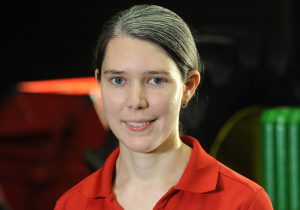Lackluster soybean yields for 2019
By Dusty Sonnenberg, CCA, Ohio Field Leader
The 2019 growing season will be remembered for many things, though bin-busting soybean yields will probably not be one of them.
“Soybean yields in Ohio are going to be wide ranging. This is largely due to the soil moisture during the growing season, both excess and drought. Soybean planting date across the Midwest is still the No. 1 factor in soybean yields. With the late planting this year, that is very unfortunate. This year the excessive wet, followed by the dry also had a huge impact,” said Laura Lindsey, Ohio State University Extension soybean specialist. “It started wet, was late planted and then some areas of the state just dried out. Wet soils led to poor root conditions, then dry conditions struck some areas, which just magnified the poor root problem. The lack of moisture during pod fill is probably a bigger issue where water and rainfall is concerned for soybeans. The final yield is impacted by sufficient moisture and timely rainfall during the pod-fill. One swath in the state that was impacted by this scenario had yield reports in the 20s per acre range.”

Areas of northwest Ohio started wet and remained saturated throughout the growing season. “Wet soils can have a negative impact on soybeans. Root growth is limited. Nitrogen fixation is reduced when the soils are saturated. That is one reason why we see yellow soybeans early on,” Lindsey said. “Wet soils as they relate to seedling diseases are more problematic to soybeans than the ‘wet feet’ conditions. And when the soil has anaerobic conditions, the mycorrhizae, the root growth, basically everything is limited in saturated soils.”
The same production challenges showed up in the Ohio Soybean Performance Trials, conducted at five locations in 2019. There were originally six locations planned, however due to the prolonged wet field conditions, the Sandusky county location was never planted. The five locations included: Clinton and Preble counties in the south, Morrow and Mercer counties in the central part of the state, and Henry County in the north. Planting dates were May 16 at both locations in the south (Preble and Clinton counties), June 4 in Morrow County and June 8 in Mercer County. The final planting was on June 12 in Henry County. Harvest of the trials was completed on Oct. 5 in Preble County, Oct. 10 in Clinton County, Oct. 15 in Morrow County, Oct. 17 and 18 in Henry County, and Oct. 19 and 20 in Mercer County.
“This spring was wet. It followed a very wet fall harvest in 2018. The southern Ohio Performance Trial locations had a very typical planting date. We usually try to plant in mid-May to escape any frost. The central Ohio locations were planted in early June. Only one of the northern locations was planted, and that was in Henry County on June 12. The Sandusky County location was just too wet to plant this year,” said Laura Lindsey, Ohio State University Extension soybean and small grains specialist. “Overall the stands were pretty good. Clinton County was the only exception. It was planted on a good date, but then the rains came and emergence was reduced due to crusting conditions.”
There was not significant insect or disease pressure in 2019 that impacted the Trials, though the season’s variability showed up in the yields.
“The growing season started out wet, but then some areas became extremely dry. The southern locations were the most impacted by the drought. This year’s growing conditions were variable by location. The average yields were in the mid-high 50 bushel per acre (bu/ac) range,” she said. “Overall, the lowest yield was 25 bu/ac, and the highest was 76 bu/ac. Preble County was hit hard by the weather, yet it had the highest yield across the performance trials. The average yield in Preble County was 66 bu/ac. It ranged from 50-76 bu/ac.”
Though Ohio’s soybean harvest is largely wrapped up, for those soybeans still standing in the fields around the state, challenges remain.
“Given the forecast with wet and cold conditions, it is recommended not to cause more compaction damage that will continue to be an issue in future years. Don’t push it too hard,” Lindsay said. “We want to minimize compaction and protect the soil quality as much as possible.”
All yield results of the 2019 Ohio Soybean Performance Trials are available online at: https://stepupsoy.osu.edu/news/2019-ohio-soybean-performance-trial-all-yield-results-available.